Journal
About Andrew Cusack
 Writer, web designer, etc.; born in New York; educated in Argentina, Scotland, and South Africa; now based in London.
Writer, web designer, etc.; born in New York; educated in Argentina, Scotland, and South Africa; now based in London. read more
News
Blogs
Reviews & Periodicals
Arts & Design
World
France
Mitteleuropa
Knickerbockers
Argentina
The Levant
Africa
Cape of Good Hope
Netherlands
Scandinavia
Québec
India
Muscovy
Germany
Academica
The Wolseley
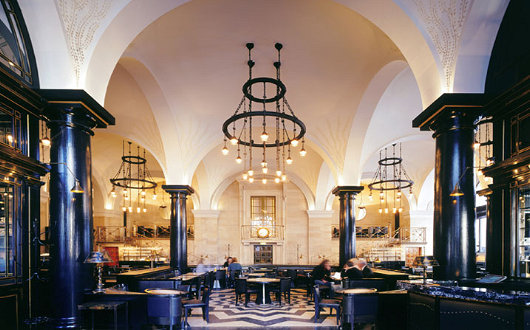
Our itineraries only had us both in London for less than twenty-four hours. Sam, now lawyering in his native Lancashire — “Recusant country, Cusack, you’d love it.” — was down in London for a party on Friday night. “How about a coffee Saturday morning before I head back up north?” Why not. “It’d have to be early though.” Blast. How early? “Say… 10 o’clock?” Well, that’s not so bad is it! Where to meet? “The Wolseley, next to the Ritz.” Never heard of it, but Sam must know what he’s up to.
Here, I have to admit that I usually hate public places devoted to the consumption of food. Restaurants irritate me and I infinitely prefer the dinner party to the restaurant appointment. Even the places I like, I actually despise in one way or another. But the Wolseley failed to irritate me in the slightest, which earns it very high marks indeed in the Grand Book of Cusack. The staff are friendly but suitably removed, the coffee is excellent, and the food tasty with portions just the right size. On Sam’s recommendation I tried the Wiener Kaffee, and ordered French toast for myself, Sam taking pancakes. Everything was just as it should be, and without any fuss. What better praise could one give such an establishment? (more…)
Kidnap and Rescue
Followers of Seraphic’s blog will doubtless have read of my Caledonian misadventure, whereby I was kidnapped by the inhabitants of an historic house in East Lothian. This update was followed by the Sexagesima Social Report, detailing our Sunday Mass, followed by the Cup of Tea of Peace, followed by the Gin & Tonic of Fortitude. Pleasant as my enforced captivity was, various duties in London obliged me to cooperate with the successful rescue effort made, curiously, by Royal Dutch Commandos.
Further ruminations on my Britannic sojourn are forthcoming.
Scotland
Written and illustrated by Andrew Cusack (at 7 years of age)
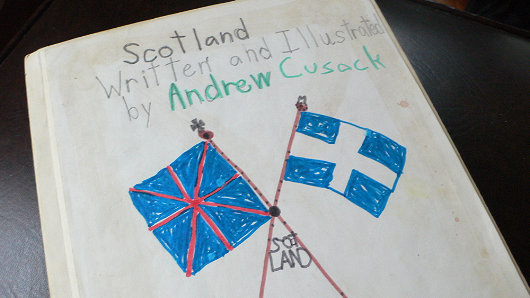
Were I to review this book, I would say it is riddled with inaccuracies and depicts a stereotypical Hollywood version of Scotland far-removed from reality. But then, it was written in 1991 by a seven-year-old (yours truly), which is already eighteen years ago now. The ultimate schoolboy error is that I was apparently incapable at age 7 of producing a vexillologically accurate reproduction of the Saltire. My incorrect version of the Scottish appears like the old Greek flag, a white cross extended across a blue field. (See the correct flag here). (more…)
Joyce Linton: The Lady with the Voice

Yesterday, in a beautiful sung requiem at St. Agnes, we paid our final respects to our friend Joyce Linton. I had known Joyce for quite some time before I ever actually met her because we tended to sit in the same neighborhood of pews (in the back of the church towards the left) at the 11 o’clock Mass at St Agnes every Sunday. While a schoolteacher by profession, she was also a trained vocal musician, and her voice carried as the congregation belted out our Credos and Glorias. She became known to me as “the Lady with the Voice”, and every so often I would see her making her way towards the church just before 11:00 and, without knowing her name, I would say to myself “That’s the Lady with the Voice”.
Eventually, I got to know Joyce well, and joined the regular tea-drinking crowd of which she was a devoted and prominent member. Vim. Moxie. Determination. Those are the words that come to mind when I think about Joyce, a spirited lady if ever there was one. But she was, also, a woman with a certain style. Think of 1950s New York, swanky, bright, and modern, but still traditional, and never out of date. That was Joyce.
Now, if there was one thing that undoubtedly went along with Joyce’s vim, moxie, and determination, it was that she had an opinion. She enjoyed a vibrant discussion and the interaction of ideas, but she made certain that even if you didn’t happen to share her opinion, you would at least be familiar with it. As it happens, Joyce and I were lucky enough to agree with one another on many things, but by no means all things. More than once did I attempt to refute her position on this, that, or another thing. After the back-and-forth had exhausted itself, she would say, “Well, I don’t think it’s quite as simple as that”, I would shrug my shoulders and say “Perhaps”, and we would sip our tea and rejoin the larger conversation.
She was a woman who was grateful for the graces in her life. She was grateful for the blessings of her family, though it was not without hardships. She was grateful for the magnificent inheritance of centuries of art and culture she was born on the receiving end of. She was a patriot if ever there was one — a proud American, but one with a devoted filial love of Europe, and especially of Italy.
I think the first time Joyce visited Italy was when she did her voice studies in Florence in the 1970s, and she never stopped going back. She had a devotion to Padre Pio and paid her respects to the great saint by pilgrimming to San Giovanni Rotondo. Towards the later years of her life she had a special love and appreciation for summer days spent at Gardone on the shores of Lake Garda, enjoying the intellectual stimulation of the annual summer symposium organized by the Roman Forum. The Italian airs invigorated her Celtic blood and she would return to New York in late summer rejuvenated and refreshed.
She always knew lots of things about New York. You can get great freshly baked bread here. They do a good brunch there. If you really want to do X, then you’ve got to Y at Z on Nth Street. I remember one drizzly November Sunday afternoon Joyce showed me “the best way to cut through Saks” as she and I made our way to the annual Choral Evensong & Flag Service for the Patriotic, Historical, and Hereditary Societies at the Church of St. Thomas, Fifth Avenue.
Joyce loved her job as a high school teacher at Manhattan Center on the Harlem River, just a few doors away from Our Lady of Mount Carmel on 115th Street. Any and all bureaucratic encroachments upon the teaching profession were vociferously opposed by her, and she had an enormous pride when her students did well (especially her girls). Latin was another excuse to spend time in Italy, where she studied the language under the famous Fr. Reggie Foster in Rome. She taught English as well, and was adamant that her students learn important lessons from writers like Orwell and Wilde, rather than a rote set of facts or ideas or quotes. She was always on the lookout for a new way of explaining the old truths to the students in her charge. She loved them, but she also loved her colleagues, and more than once had us praying for this one or that one.
When she was first diagnosed with cancer, many of us prepared ourselves mentally for The End. I think Joyce said to herself “Well I’m not having any of that.” She beat it the first time round (remember what I said about vim, moxie, determination?) to the surprise of many, probably her devoted doctor most of all. She went back to work, and her own hair grew back, allowing her to dispense with the peppy wig she had specially styled. Life, it seemed, returned to normal, for one last Halcyon day before the Hour approached. When the time did appear on the horizon, her descent was rapid. I’m glad I had a chance to see her one last time, surrounded as she was by friends in Lenox Hill Hospital.
Joyce would have loved her requiem, the priest in mournful black trimmed by resplendent gold, acolytes and torch-bearers aiding in the sanctuary, the Dies Irae rising from the choir loft, and those who knew and loved her pleading God’s mercy and quick remission of her earthly transgressions. It was beautiful — as the most beautiful things are — because it pointed towards that Heavenly place from whence our only glories come, where we pray “the Lady with the Voice” will enjoy perpetual light and rest eternal.
Requiescat in pace.
Amen.
221B Baker Street
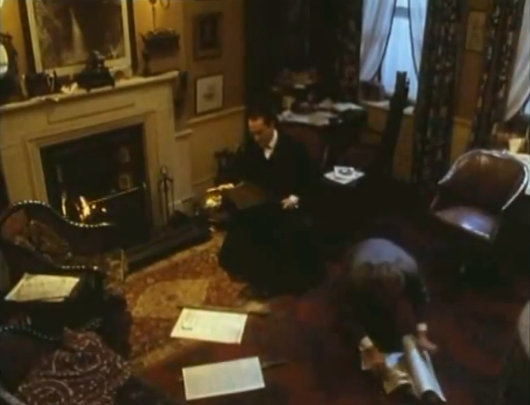
I think the ideal model for bachelor digs must be No. 221B Baker Street from the Granada TV production of Sherlock Holmes (Jeremy Brett’s performance as the title character being his most enduring and remembered role). Needless to say, one would have to have Mrs. Hudson as well, lest one starve to death or suffer the ignominy of microwaved meals.
Novanglian Peregrinations
A journey to the shining city of Saint Botolph, and return
THE PERIOD OF MY removal to South Africa sometimes inclines me to think that time stood still during my absence from the northern hemisphere. It is as if the mental chronicle of my brain simply ceased, and took up writing in a different book, and then went back to the end of the old page upon my return. But time indeed did pass, and many were the old friends and acquaintances with whom we had not combined in some time. Communication was no better than intermittent while exiled in southerly climes, but, freshly returned, the tom-toms were beat and the smoke signals sent to the usual suspicious characters of note. A convocation of cohorts and old confederates was then proposed, to take place in Boston — caput and urbs maxima of God’s own province of New England.
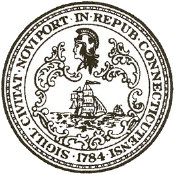 My first stop was actually New Haven, and traversing the border into Connecticut I crossed myself in accordance with ancient custom, invoking the guardian angel of that jurisdiction in the usual pleas for safe travel, easy passage, and the avoidance of traffic cops & parking fines. In New Haven, I attended the meeting of a learned society (composed of both postgraduates & undergraduates) devoted to polite discourse, under the sacred patronage of the Saints Augustine of Hippo and of Canterbury, and the secular patronage of the Anglo-Irish divine Bishop Berkeley. Speaking of the divine, the society’s meeting was preceded by Mass, offered by one of the Dominicans who unofficially tend to the flock of Yale students (the official Roman chaplaincy there having a poor reputation) in an improvised chapel at the club’s quarters.
My first stop was actually New Haven, and traversing the border into Connecticut I crossed myself in accordance with ancient custom, invoking the guardian angel of that jurisdiction in the usual pleas for safe travel, easy passage, and the avoidance of traffic cops & parking fines. In New Haven, I attended the meeting of a learned society (composed of both postgraduates & undergraduates) devoted to polite discourse, under the sacred patronage of the Saints Augustine of Hippo and of Canterbury, and the secular patronage of the Anglo-Irish divine Bishop Berkeley. Speaking of the divine, the society’s meeting was preceded by Mass, offered by one of the Dominicans who unofficially tend to the flock of Yale students (the official Roman chaplaincy there having a poor reputation) in an improvised chapel at the club’s quarters.
Mass was followed by port, smoking, and some cheese & finger foods for the hungry souls. I mentioned to a friend that the Choco-Leibniz cookies on offer were my favourite, the official state biscuit of the house of Cusack. “Of course they are,” the wag responded. “Choco-Leibniz are the best of all possible biscuits!” (Some jokes are so bad that the resulting chortles are both inevitable and involuntary.)
Then, the subject at hand. This meeting was convened to discuss the recently announced Apostolic Constitution establishing “personal ordinariates” to ease the reception of Anglican Christians into full visible communion with the Pope. The assembled members were by no means only Catholics, but with a significant portion of Episcopalians, and the odd Calvinist for good measure. A brief paper by an entrenched Anglican was read, and the members responded and discussed the matter with courtesy and depth as the fire crackled in the background. Which groups are likely to take advantage of the coming ordinariates? Which are least likely? Was this chiefly a pastoral move? What do the Orthodox think? What will the reaction be outside North America? All these questions and many, many more were raised and, so far as possible, answered.
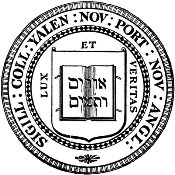 The formal discussion was concluded with the invocation of the two Augustines and a toast to Bishop Berkeley. A number of members remained by the fire while others dispersed for other events. The weekend beheld the 75th Anniversary of the Yale Political Union, and so the constituent parties of the YPU were all having events for their members and alumni. (From what I can understand of the YPU’s right-leaning parties, the Conservative Party is for Republicans, the Tory Party is for decadent Anglophiles, and the Party of the Right is for conservatives.)
The formal discussion was concluded with the invocation of the two Augustines and a toast to Bishop Berkeley. A number of members remained by the fire while others dispersed for other events. The weekend beheld the 75th Anniversary of the Yale Political Union, and so the constituent parties of the YPU were all having events for their members and alumni. (From what I can understand of the YPU’s right-leaning parties, the Conservative Party is for Republicans, the Tory Party is for decadent Anglophiles, and the Party of the Right is for conservatives.)
Following the procurement of beer and the ordering of pizza, the consumption of both, and the extinguishing of the fire, it was time to retreat for the evening to the splendid old Victorian house where a number of folks live. It’s one of those old, solidly American homes, with a swinging chair on the porch, splendid wood detailing inside, and pocket doors between the receiving rooms. Dotted around an old dining room table, more news and rumours were exchanged between the inhabitants and guests as the remnants of a bottle of Macallan was polished off. The Choco-Leibniz joke was repeated for those who were not in attendance before. A South Carolinian’s reaction to the health-food movement was recalled: “They won’t buy an egg if it ain’t free-range but they put on all manner of uh-koo-tra-mints so as not to conceive!” One of our friends, an Englishman, treated us to a rendition of “Come Thou Font of Every Blessing” on the banjo, and we were informed that a group of Yale Divinity students were officially reprimanded for having a watermelon-eating competition. (Watermelons often feature in stereotypical caricatures of American Blacks, and thus are apparently forbidden by the Monotony Monitors). We went on in such manner until the wee hours, when the assembled finally adjourned to bed.
Then the morning: breakfast — pumpkin pancakes from S.O.’s wife before she popped off to riding practice — before A.L. and I combined to continue the journey onwards to the City of Saint Botolph, Boston. The city’s name comes from the Lincolnshire town of Boston, itself a contraction of “Saint Botolph’s Town”. Many of the Puritans hailed from the East Midlands, and it was John Cotton, the controversial Vicar of Saint Botolph’s Church in Boston, who encouraged many separatist radicals to emigrate to the Massachusetts Bay Colony in New England. The New-World town of Boston was founded in 1630, and named in honor of the place associated with Cotton, who himself emigrated three years later. The Church of Saint Botolph is the most prominent landmark of old Boston, founded in 1309 and famous for its late-fifteenth-century English Perpendicular lantern tower. As coincidences go, the design of Harkness Tower at Yale University in New Haven is inspired by that of Saint Botolph’s in old Boston. New Haven’s name also harks back to the River Haven which flows just some thirty-odd feet from the great tower of Saint Botolph.
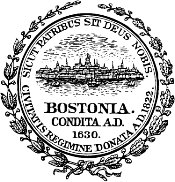 A New Yorker is always of two minds about Boston. We consider it a somewhat uppity member of our northern periphery and despise the attitude of some of its lowlier inhabitants (the sporting fans of red hosiery), but the old Knickerbocker can’t help but envy the skill and ability with which the Bostonians have preserved so much that has been utterly destroyed in New York. Boston, despite its politics, might just be the most conservative town in the American Republic. During our stay in Boston, we never left the immediate vicinity of Beacon Hill and Back Bay, except for one foray into Chinatown for dinner. The architecture is splendid, traditional, and vernacular, and the streets are uncrowded compared to the vast hordes that swarm around Manhattan.
A New Yorker is always of two minds about Boston. We consider it a somewhat uppity member of our northern periphery and despise the attitude of some of its lowlier inhabitants (the sporting fans of red hosiery), but the old Knickerbocker can’t help but envy the skill and ability with which the Bostonians have preserved so much that has been utterly destroyed in New York. Boston, despite its politics, might just be the most conservative town in the American Republic. During our stay in Boston, we never left the immediate vicinity of Beacon Hill and Back Bay, except for one foray into Chinatown for dinner. The architecture is splendid, traditional, and vernacular, and the streets are uncrowded compared to the vast hordes that swarm around Manhattan.
Our home for the time being was a handsome apartment in Beacon Hill, well-decorated and amply supplied with books and booze. A.L. and I parked the car in the garage under Boston Common, and were met by our close friend I.M.C., who is the lynchpin uniting this social circle. I.M.C. hails from north of Boston, towards Gloucester, but had arranged for his friend T.L.G. to host us in his flat overlooking the Public Garden. Upon arriving we were offered generous cups of tea, ginger snaps, and sliced mango and conversed for quite some time before we decided upon a light Saturday afternoon jaunt around Back Bay and Beacon Hill.
T.L.G. explained the creation of Back Bay from landfill as the four of us swaggered down Commonwealth Avenue, be-tweeded on this autumn day. We popped into the Boston Public Library just before closing, and gazed out onto Copley Square that was once the epicenter of the city. The square is or was, at various times, home to the Public Library, Old South Church (Cong.), Trinity Church (Episc.), the Massachusetts Institute of Technology, the Museum of Fine Arts, and the Copley Plaza Hotel. Sadly, it is now disfigured by the looming bulk of the John Hancock Tower, a modern skyscraper by I. M. Pei that is the tallest building in New England. It was so shoddily constructed that entire panes of glass began to fall off after it was completed, eventually forcing the owners to replace ever single pane of glass within just a few years. We swung by the Church of the Advent where our host is a parishioner and whose Lady Chapel and rood cross were designed by Ralph Adams Cram. Just after we exited the Church, we were introduced to the Rector, who was just coming home from the wine shop.
Returning to the apartment, it was time for drinks. The gin flowed like wine, and it wasn’t long before we were joined by J.T., A.R., and M.D. All manner of things under Heaven were discussed, from the latest exploits of mutual friends, to matters of state, and of course church affairs (this is a half-papist, half-’piskie crowd). Said discussions continued around a table for seven at the Taiwan Café in Boston’s Chinatown. (Good to support Nationalist China, but it did require crossing Boston in the rain). Our dinner of pork, dumplings aplenty, soup, and tea finished, we progressed to a certain private club for more drinks. M.D. treated us to his side-splitting imitation of Katharine Jefferts Schori and Peter Akinola having an argument before the evening finally came to it’s conclusion.
Sunday morning, breakfast of tea, sausages, and proper porridge. Despite all the previous evening’s drinks, not so much as a hint of a hangover. Stood on the balcony overlooking Charles Street in the unseasonable warmth and began to appreciate Boston’s existence. I.M.C. cordially invited us to visit his home town of Beverly, a good New England town north of Boston and on the sea. Lunch, evening Mass, dinner, more good conversation throughout. But an early morning’s rise on Monday, to make it back south home to New York, ending a fine and invigorating peregrination through at least part of New England.
The Old Slave Quarters
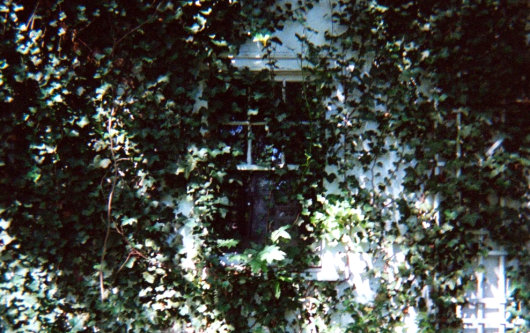
A child’s imagination can transform the humblest construction of pillows into a fortification to equal the Krak des Chevaliers. On the grounds of my old school, there was a shack in a state of advanced dilapidation which I decided was an old slave cottage. I knew there was absolutely no chance of this being factually accurate — it probably didn’t date from any earlier than the 1910s — but one could easily picture Aunt Jemima living an abject poverty within its slowly crumbling walls. The shack was in one of the more peaceful corners of the school grounds, and there was an old rope hammock nearby, to which I would occasionally repair for a brief nap after a lunch of particular vivacity.
Despite its advanced deterioration, I found it a charming little structure, and it always saddened me that every map and plan I shuffled through in the Headmaster’s Office featured the parenthetical “(to be demolished)” atop the building’s outline. Indeed, it may have been destroyed already. (more…)
The End of the Affair
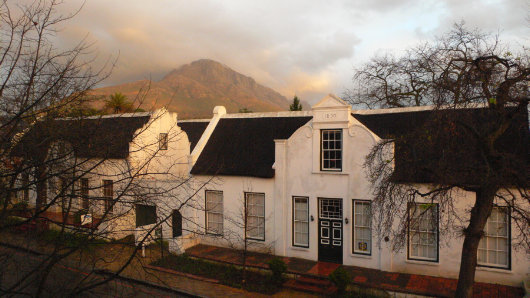
HOW CAN ONE possibly summarize a portion of one’s life? Those first warm breaths of African air as I stepped off the plane at Cape Town International. The stern-faced mustachioed driver who drove me to Stellenbosch, the town that became my home, on my first day on the African continent. My strongest memory is just pure sunlight. I had flown down from the deepest winter of the northern hemisphere, and the sun’s warm embrace was a welcome change. As we entered the valley of Stellenbosch, my solemn driver broke the silence and asked what business was taking me there. Learning that I came, at least in part, to study Afrikaans, his dour visage was suddenly enlivened, and he earnestly gave every assurance that I would enjoy myself in Stellenbosch immensely.
The town itself is handsome, full of white-washed walls and pleasant streets lined with old oak trees, some planted by that Dutch governor of old, Simon van der Stel. He gave the town both its name — Stellenbosch, van der Stel’s wood — and its other moniker, Eikestad, the city of oaks. The most remarkable feature of the town, however, is the beautiful range of mountains that flank it on either side. My window happened to look out on Stellenbosch mountain itself, and I admit a certain territorial feeling towards that berg has formed through the several mornings, noons, and nights it has stood watch over me.
But pleasures though there are in Stellenbosch — a stroll the Botanical Gardens, a pint at De Akker, dinner at Cognito where they know my “usual” Tanqueray-and-tonic — even more awaits the Stellenboscher who ventures further afield. I went as far as Lüderitz in Namibia, one of the furthest extremities of the old German empire. But nearby Cape Town itself provides enough to keep the ardent traveller intrigued. Table Mountain, whose looming presence over the city frames the moederstad perfectly. Further along to the pleasant sands of Clifton’s beaches, the port of Simon’s Town, and down to the end of the Cape itself — the end of Africa, where two oceans meet.
And across False Bay to Rooiels and Betty’s Bay, to the Kogelberg reserve where the hiker’s efforts are rewarded by the seclusion of a splendid little swimming hole. Floating to and fro in the little river pond, being sung to by fair Finnish maidens — there are worse ways to spend a summer’s afternoon. But it’s also glorious to be alone in Kogelberg; to hear the silence of the dead summer, outstretched arms floating along, grazing the tall grass and the heather beside the way. The open, breezy country and the quieter nooks lodged between, whose heat betrays their stillness of air. Barely any sound but the crunch of foot upon path, the wind rustling through the plants, and the odd chirp of insect here and there.
And where else? To Wupperthal, where the barefoot coloured children play happily in the eucalyptus-lined street leading to the old Rhenish mission. To Kakamas, where the farmer invites us to lunch with his family, and guides us around just a few of his 600,000 acres. To Hermanus, spending two glorious hours clearing invasive plant species from a field before breakfast — that damned Ficus rubiginosa! To Greyton for a winter’s lunch beside the fireplace, and to Genadendal, the “valley of Grace”, the queen of the Moravian missions.
And with whom? Ah, the easy acquaintances of a university town. Friends from class, friends from the pub, friends from the bistro, friends of friends, and friends of friends of friends, who all end up as friends. To the beach on Friday? The cinema tonight? The pub quiz on Tuesday? A coffee tomorrow afternoon?
The people, more than anything, make the deepest impression — both the South Africans and my fellow travellers. Good times shared and conversations enjoyed. Some surprising friendships spring forth from the unlikeliest of places and the most scant of connections. And stories are shared of varying experiences. Poor Ralf almost getting done in by that hippo in the Kalahari! The intervarsity match — another victory for die Maties. And the second test match against the Lions — Morne Steyn, that kick! A genial cup of tea in a well-kept house in Oranjezicht as the resident explains how many times she’s been burgled. The Kayamandi girl whose father disappeared long ago, whose stepfather abuses her every night, and whose mother is entrapped into acquiescence by poverty. A student dies from swine flu — a first in South Africa. Another is murdered by the obsessed friend of her older brother. The police beat the suspect so badly he cannot appear in court. The headline in the Eikestadnuus proclaims “Vyfteen weeks, vyfteen moorde” — fifteen weeks, fifteen murders in this pleasant little corner of the Cape. The latest exhausted statement from Kapt. Aubrey Marais of the Stellenbosch police. An email from the university rector: male students are reminded not to allow girls to walk home unaccompanied at night. In the face of all this, ordinary lives continue unintimidated.
This country has a tendency to seep into the veins, to get under people’s skin. There is no brief affair with South Africa. Her own sons and daughters dot the globe — thousands are in London alone — but they earn their keep abroad while they yearn for the land they left. (“They just miss having servants” half-jokes the farmer’s wife.) Some do leave forever, but many more come home after a few years. My time is up, I leave South Africa today, but I can’t help but think the affair is not over, even if it only continues from afar. It is difficult to escape the lure of this deeply troubled, deeply blessed land.
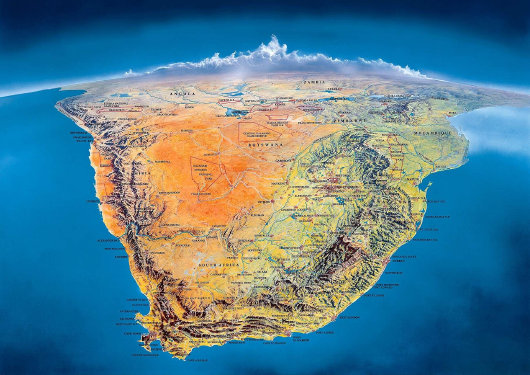
Some reading notes
ROBERT O’BRIEN, IN a deliberately provocative gesture, once said in conversation that he pitied America for not having any literature. Preposterous! was my natural response. We have Chaucer and Shakespeare and Mallory and Dickens! Yes, you Britons have them too, but you will have to share, I’m afraid. To try to separate America from the English greats is the equivalent of forbidding a son from taking pride in his family’s long and illustrious history. He may not be the eldest male descendant, but does this mean he must deny his heritage? Of course not. Naturally, like the Scots and the Irish we have our own subset of English literature — Mark Twain, F. Scott Fitzgerald, Flannery O’Connor, and J.D. Salinger come to mind — and there are even a few crossovers such as Henry James and T.S. Eliot.
The idea of doing a degree in English or in any literature has always seemed unattractive to me, though I by no means advocate the abolition of English departments. Perhaps it’s because I rarely found English a compelling subject in high school, though I did have some extremely talented teachers: The P (as she is known), as well as Mr. Leahy. I am one of those no doubt millions who wishes he had actually read all those books he supposedly read for class at school. I did enjoy Sophocles, and Homer too, but I did not really get into Flaubert (I intend to revisit him). Crime and Punishment I soaked up at the time, but have since forgotten.
How tiresome it must be, as a formal student of literature, to be forced to answer questions about works you have read. I wonder if there should be two tracks within universities: one for gentlemen, who merely seek to learn, and another for budding academics, who need proof they’ve learnt something. Some books have taken years (and multiple readings) to truly sink in, so it seems preposterous to arbitrarily require a succinct series of answers to examination questions at the end of a term.
Idea-driven novels seem foolish to me as well. In New York, I knew a Frenchman, not much older than myself, who (I discovered) was in the midst of writing a novel. Intrigued, I asked him one day what the novel is about. He paused for a few moments, sat back, and slowly tapped his finger thrice on the table in thought, and said “Stratification”. Well! Call me a simpleton but I would have preferred “a guy, a girl, a plot, an affair, schoolmates, a day, a week . . .” anything, but “stratification”?
Well, he is writing in French, and if you are going to write an idea-driven novel, it’s probably best to do it in French.
What have I been reading lately? A few months ago I finished Erskine Childers’ The Riddle of the Sands — an absolutely cracking book. It was late in the African summer, and I was perched appropriately on the sands of Kogelbaai — one of the most stunning beaches in the Cape. What’s more, it was a weekday afternoon, and so the strand was abandoned but for our small party, so we sat, read, napped, explored the rocks, and enjoyed the beauty of our surrounds. Another cracking read was Chesterton’s The Man Who Was Thursday. The author subtitled his book “A Nightmare” and it had moments of utter fear and dread, but also, being Chesterton, moments of ridiculous farce and hilarity: a fascinating insight into the mind and mentality of a jovial and saintly man.
H.V. Morton, the man who convinced me to come to South Africa with his In Search of South Africa, showed me the Eternal City with A Traveller in Rome, and I am so tantalizingly close to finishing that magnificent work of Thomas Pakenham (now Lord Longford, since the death of his father), The Boer War. Pakenham is an historian beyond compare. I began Kristin Lavransdatter to great enjoyment, but am waiting till my return to New York to complete it. I started The Prisoner of Zenda while travelling in Namibia and finished it on Pentecost weekend. Boswell’s Johnson I found an excellent little india-paper edition of in a tiny back-alley shop in Wells last year (we ran into Michael Alexander on the street) and I’ve been pottering through it bit-by-bit. On the recommendation of Stefan Beck I picked up J.P. Donleavy’s The Ginger Man but found it obsessively vulgar and, worse, boring, so returned it to the goodly people at the Universiteit se biblioteek.
I still have out from the library a handsome, handy, small German printing of Legends of the Rhine (translated into English). I like small books, books you can easily fit in the pocket of a field coat and whip out at a moment’s notice. At a reception in a New York gallery some time ago, I learned from John Derbyshire that the determining factor of the old Penguins’ size was that it would fit in the front coat pocket of a British Army officer. The new size of Penguins are much too large to carry about as emergency reading, which makes me very glad that they’ve brought back the older, smaller size.
Penguins aside, I still prefer those shorter, fatter editions printed on thinnest india-paper. Jocelyn, my cook at university, gave me such a copy of The Pickwick Papers (inscribed “To Andrew Cusack — one of the most Pickwickian individuals I have ever met”) for my birthday one year, and it is one of the dearest editions I own. Does anyone print on india-paper anymore? I suspect not, and more’s the pity. Michael Wharton (better known as Peter Simple) noted shortly before his death how difficult it was becoming to obtain sheets of foolscap in London. Thus passes the glories of the world…
Betty’s Bay
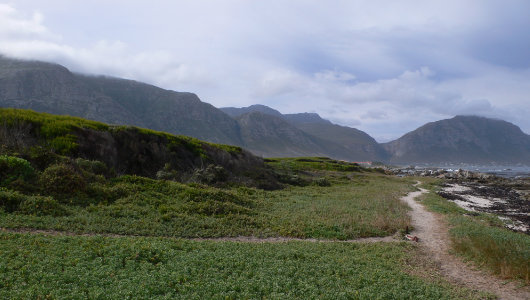
Travelling down the east side of False Bay, through the happy town of Rooiels, past Pringle Bay, and around Cape Hangklip sits the little village of Betty’s Bay. Nudged between the waters of the Indian Ocean and the rugged mountains of the Kogelberg, this is one of the most beautiful corners of the Cape. At the same time, it is just sixty miles (as the crow flies) from die moederstad itself — Cape Town. In days long since past, Betty’s Bay and the surrounding area of the Overberg were the hiding places for runaway slaves, sailors deserting their vessels, and smugglers of every kind. The Overberg takes its name because it is over the Hottentots Holland mountains from Cape Town — just outside the immediate purview of the earnest authorities in that swarming port, the “tavern of the seas”.
Journey to Scotland
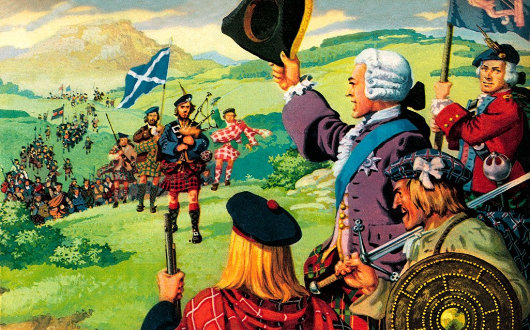
Perhaps foolish to title this entry ‘Journey to Scotland’ as I’ve already crossed the border into England, and indeed my train has just crawled past the beautiful towers of York Minster. I arrived in Scotland on Saturday and neglected to make the pilgrimage to my alma mater of St Andrews but instead spent all of my time in the elegant confines of Edinburgh. Saturday night beheld a splendid repast, including salmon freshly arrived from Ireland, champagne, and brandy cake. After the glories of an old-rite Mass on Sunday morning there was tea aplenty (and brief chats with Gerald Warner and Fra Freddy) before enjoying tankards of champagne near Queen Street Gardens, followed by an excellent late lunch in one of Auld Reekie’s best Italian restaurants, topped off with hot apple pie and a bit of Bas Laubade armagnac (1946).
On Monday I took a break from eating and called at one of my favourite paintings in the National Gallery on the Mound (Pas Mèche by Jules Bastien-Lepage) before a pub lunch with very good friends. A few pints in the Guildford Arms next to New Register House (home to the Court of the Lord Lyon, for those heraldically inclined) led to the standard student dinner of spag bol in a flat off Morningside Road. Yesterday, however, my old friend Richard Demarco led me on a personal tour of Arthur’s Seat and Salisbury Crags in Holyrood Park. A most remarkable guide, with a flair for the dramatic, Richard adeptly explained the ancient significance of the stunning site and declared it a monument even greater than the Pyramids because, unlike those Egyptian constructs, these crags and hills were made not by man but by God.
One of the false conveniences of the modern internet lifestyle is that global websites often redirect themselves to the local version when one is outside the United States. In Montreal just a few weeks ago, I put in “google.com” and automatically got “google.ca”. Similarly, in Scotland, logging out of YahooMail, one is redirected to “yahoo.co.uk” rather than “yahoo.com” regardless of your actual email address. More curiously, however, while passing through Northumberland, I logged on to “google.com” and was redirected to “google.se — Google Sverige”, the Swedish version of Google. Have the Northmen returned, albeit electronically, to claim back the lands that once were theirs?
I am now off to London. My aforementioned friend Richard Demarco is, for lack of a better phrase, big in the arts world of Scotland; this is so despite his strident opposition to much of the arts establishment. Richard believes that divine veneration must be the animating spirit of great art, and that the current reign of nonsense and malarchy in art stems from its divorce from the reality of the Incarnation. For veneration, then, tonight’s eve of the New Year will be commemorated at Brompton Oratory with a Holy Hour and Benediction starting at 11:00pm. Tomorrow’s feast will be marked by yours truly at Spanish Place, where a Solemn High Mass in the Extraordinary Form will be celebrated.
Arrivederci, then, to 2008, and a very happy and blessed new year to all the denizens of this little corner of the web.
Plumbing Cusackian Depths?
Robert Harrington recently insisted on interviewing me, taking many of his questions from a previous interview years ago which had been available at andrewcusack.com but which has since inexplicably disappeared into the ether. (Such are the mysterious ways of the internet). Mr. Harrington unconvincingly insists that the previous interview provided an interesting insight into the mind of Cusack, and no doubt he hoped to gain further useless insights with this period of interrogation. We will leave it to the reader to judge. What follows is an only barely edited version.
You’re known as an architecture fan. What’s your favourite city?
Edinburgh. Finest city in the British Empire.
Finer than London?
Oh, I’d say so. London has a great deal going for it — better clubs, for example — but it’s become incredibly vulgar. And foreign. Edinburgh is ten times as beautiful. What is more beautiful than an Edinburgh sunset, with the waning light reflecting off the stone buildings and the various spires and towers? The topography of the city is its saving grace, but can also be an incredible hassle. If you want to walk along George Street or Princes Street or the Royal Mile, you’re fine. But any perpindicular perambulation becomes a matter of climbing hills and stairs and such. Yet it makes the city all the more worthwhile somehow. It’s very striking.
Your favourite building though, the old Irish Parliament (now the Bank of Ireland) is in Dublin.
Dublin also has a great number of brilliant edifices, great buildings. Not just the Bank of Ireland but Trinity College, the Castle, the Four Courts, the Custom House, the King’s Inns and Henrietta Street and all those Georgian buildings. And two medieval cathedrals! But no, Edinburgh is still finer, and unsullied by republicanism.
But the ugly Scottish Parliament building is in Edinburgh.
True, true. A recent goiter upon an old friend though. Surgery can remove such things, if the patient is willing and a surgeon can be found.
The Blessing of an Apartment
Fallen Sparrow, a denizen of the Queens neighborhood of “Côté du Bois“, gives the low-down on the blessing of Matt Alderman’s apartment and unveiling of a new graphic work last Saturday. I acted as acolyte, which pretty much consisted of holding the bowl of holy water.
Herr Sparrow also covered the Dominican Saints Party that Matt threw at his place a little while back, in which partygoers nearly came to blows over which was better: the Basilica of Notre-Dame de Montréal or the Cathedral of Notre-Dame de Québec.
The almighty loden coat
 Judging by the evidence (yours truly, left, in Connecticut late last fall*), I quite agree with the fellow who wrote in The Field this month:
Judging by the evidence (yours truly, left, in Connecticut late last fall*), I quite agree with the fellow who wrote in The Field this month:
Will ye no’ come back again
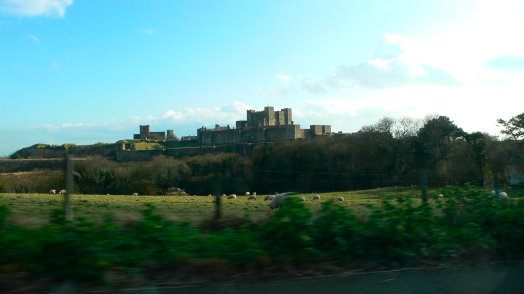
I am back already, which seems far too soon, and yet I had an immensely splendid time. It felt like more than just a week and I am sure that is due to the extraordinary generosity of my numerous hosts and friends in Scotland and England. I present to you two photographs I took during my recent trip: alas they are both in England, and indeed both in Kent, which is not terribly representative as I covered territory as far up as the choppy white waves of the North Sea and as far down as the White Cliffs of Dover. Above is an action shot of Dover Castle taken from the car, and below is the gatehouse to the cathedral close in Canterbury.
Why no Caledonian pix, you ask? I was simply too busy enjoying the place. Besides, it is a not-widely-known fact that photography does not actually function north of the Tweed. In a mandatory practice originating in a nineteenth-century labour dispute, all photographs smuggled out of Scotland are actually clever reproductions created by a secret guild of gremlins. This ensures both full employment amongst the gremlin population, and their complete separation from the ordinary human world (though a quick glance at the Scottish Labour party might cause one to doubt this is still enforced).
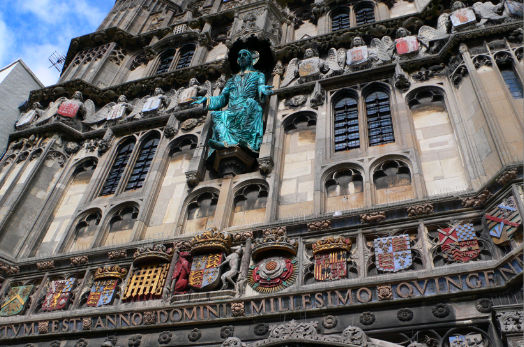
New & Improved
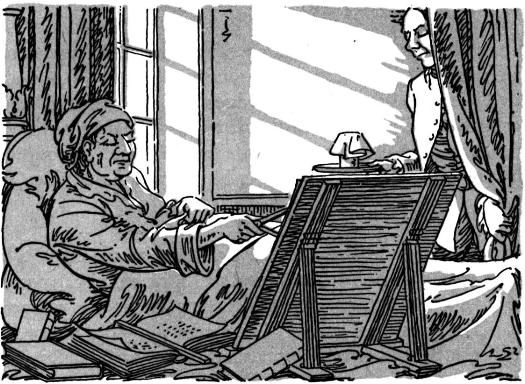
NO DOUBT YOU have been wondering what we have been up to. In truth, I had been beset with a grievous illness of the gravest nature. Bedridden, I scratched and scrawled and made calculations for the expansion of this little corner of the web, which I then had Hogarth (seen above, bringing me some hot toddy in my poor condition) send on to the architect. I have now recovered and my scratchings and calculations have born fruit. The result, you see before you: a new, improved, rather wider andrewcusack.com. Many elements have been made a bit cleaner than previously, while one or two things here and there became a bit clumsier in the construction process. I am sure you will pardon the niggling infelicitous remnants when you chance upon them. At any rate, the general result is an expanded central column, in which we can exhibit to you even broader and bigger images to enlighten you, brighten your day, or raise your ire, whichever the case may be.
(P.S.: I very rarely give advance notice of things to come, but you can of course expect a proper appreciation of the late Rt. Hon. Ian Douglas Smith in the coming days, now that the scaffolding is down and our new edifice complete, as well as at least one more entry in my ‘Maces of America‘ series, and so on and so forth…)
USMA 37, Temple 21

A HIKE UP into the Hudson Highlands, to see West Point trounce Temple University 37-21. (The last time I saw Temple play at Michie Stadium was in September 1994, when they beat Army 23-20). Army opened this game well by scoring a touchdown and field goal in the first minute, but gave the Temple Owls too much leeway, matching Army 21-21 by the half. Luckily, the Black Knights pulled through in the second half and finished the Owls off rather nicely. (more…)
A Walk in the Country
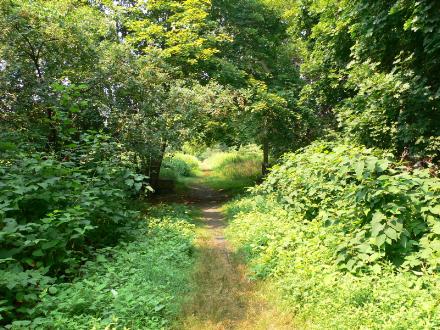
In need of a little fresh air this morning, I went for a walk amidst the lush greenery of our fair county, and took a few snapshots to show you my explorations. Shall we? (more…)
California Wedding
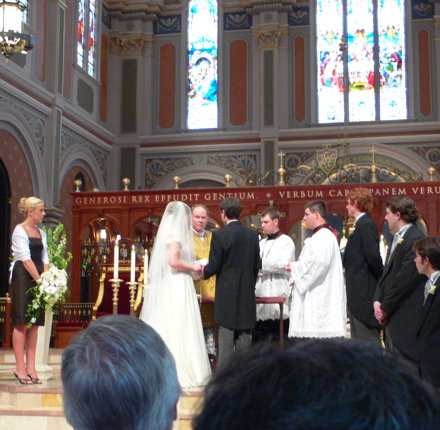
WHERE DOES ONE begin? Scotland, I suppose. I’ve known Abby since Day One in St Andrews. I was among the number of poor souls who were foolish enough to participate in the ‘overseas orientation’ for non-UK/RoI students. Through pure chance, a group of us who sat down to dinner in Andrew Melville Hall that night decided to venture into town that evening and see what was what. We went to the Central, which became my regular for a very long time, until replaced by the Russell for my tertian and magistrand years. Jon I met just over a year later, during his first few weeks at St Andrews (as I entered my second year). It was at the Catholic Society and he told me he came from Bristol. I was fairly ignorant of Bristol other than that it is home to the British Empire and Commonwealth Museum. I asked Jon about the museum and his answer was such as to confirm that he and I were on the same page of the book, so to speak. He didn’t come much to Canmore at the start and so we were not instant friends, though I do recall running into him in the corridor of New Hall at 2 or 3 in the morning one night and striking up a brief conversation (most likely telling him he ought to be coming to Canmore, since like-minded folk are a dime a dozen there).
Anyhow, by some time or another we were all best of friends, and both Jon and Abby have been the source of (and butt of) so many of the great amusements we enjoyed at St Andrews. Good God, how many laughs! In Canmore, the Cellar Bar, the Central, the Russell, in flats, in Edinburgh, in Rome, in Dublin, in New York, and most recently in California, whenever one is with Jon and Abby there is always a good time to be had, and an appropriately inappropriate comment to relish. I have picked up the habit of simply saying “ledge” (that is, short for “legend”) every time I utter the name of Jon Burke. Abby once desired that I verbally express precisely what it was that makes Jon such a legend, but all I could say was that it was of the same nature as the Sacraments in Eastern theology: appreciated, nourishing, and clung-to, but ultimately a mystery.
It was California then, which was host to our latest adventure, namely the joining in matrimony of Miss Abigail Hesser and Mr. Jonathan Burke. I flew in on Wednesday and upon checking in at the hotel, the desk clerk handed me a written message from Jon: “We’re in the bar, free cocktails!” The wonderful rehearsal dinner was the next evening, and I was privileged to have the best seat in the house, with Fr. E and Mrs. Hesser on my left and Abigail and Jon on my right. But Friday… Friday was the wedding! (more…)
The Knights of Malta Ball 2007
THE MONTH OF FEBRUARY returns, and so too the Knights of Malta Ball with its requisite sojourn to Edinburgh. If I have a confession to make, it is that I am a creature of habit, and having gone the past three years, I didn’t see why the intervening distance of the Atlantic Ocean should make any particular difference this year. If I may make another confession, it is that I am incapable at organizing things competently, and of course left sorting out tickets to the last week. “Impossible,” quoth Zygmunt Sikorski-Mazur when I contacted him. “Too late I’m afraid, and there is even a waiting list of people who’ve paid up just in case tickets become available”. Well, I had accommodated myself to the concept of heading up to St Andrews and having a grand night out instead, but luckily C. came to the rescue. “Perchance,” saith the youthful Old Harrovian, “I have a spare ticket and you can have it if you wish”. Well, that settled it.
Carried off by taxicab to the Assembly Rooms in George Street from the similarly-monikered Assembly bar in Bristo Square, it was something of a disappointment to find the fine Georgian building veiled in scaffolding and lacking the usual looming Scottish standards of the Order (smaller version seen here) and the flanking flags hanging, floodlit, from the splendid façade. Nonetheless, the Assembly Rooms have been in need a fixing-up for some time now, so it’s a relief to know that the City of Edinburgh have finally coughed up the dough. Interior restorations are to follow in the coming years, but then where will the Ball during such a restoration? Ed Monckton suggested the Castle as an acceptable substitute, and I’m inclined to agree.
It was quite the enjoyable ball, as per usual. His Eminence the Cardinal Archbishop of St Andrews & Edinburgh was affable as ever. (Last year, a photo of His Eminence, Lt. Col. Bogle, Abigail, and myself at this very event made it onto the social page of Scottish Field. I hope that is as far as my life in the limelight goes!). I ran into Fra’ Freddie (Crichton-Stuart) and he exclaimed “What are you doing here!”, though he subsequently admitted that his “little spies” had, actually, informed him I would be popping over from New York. Ed Monckton shared an amusing tale of his late grandfather and the Duke of Wellington commandeering a tank to gain entry to a public house and disengaging street lamps by means of firearms. California’s own Chevalier Charles Coulombe, of course, talked to everyone, even the bouncers, who had a decidedly mafioso look to them this year. I, forgetfully, neglected to pick up a pack of Dunhills beforehand, but Gary Dench and I ran into Albert and he kindly offered his brand: an excellent, unfilitered variety of (naturally) German origin.
One of the unintended consequences of the Scottish smoking ban is an increase in socialization: a greater appreciation of the brotherly bonds of nicotine intake. Now that we of the smoking habit are forced to congregate outside entrances you have an instant bond of solidarity with complete strangers. I met an Austrian fellow named Camilo, an Edinburgh University student, and we agreed on the excellence of the Scottish system of higher education. (If one could dignify it with that term; perhaps ‘style’ is a better word than ‘system’). As it turned out, he had also spent some time in dear old Argentina, and so we swapped stories of the people and their particular ingenuity.
Later, Zygmunt introduced me to his son Nicholas, a very intelligent fellow who sounds terribly Scottish because he was educated in France rather than England with all the other Scots. (Alright, some Scots are educated in Scotland. There are Gordonstoun, Fettes, Glenalmond, and elsewhere needless to say). There were also two young Cypriot ladies, sisters if I recall correctly, who were very charming and whom we managed to drag onto the dance floor for a reel (and one of whom even managed to drag me onto the dance floor later in the evening). Typically, their names have been filed away in some deep but, alas, inaccessible fold of my brain. At any rate, we all agreed that the Turks ought to be given the boot. (Seems to be a recurring theme in European history, eh?).
Jamie Bogle was extremely late in arriving, and it turned out there was a story behind it. The trains from London were a typical shambles and there was every type of delay imaginable. Having used his mobile to make a phone call, the good Lieutenant Colonel was approached by another fellow asking if he could make a call. Jamie happened to overheard the fellow discussing “chambers” and so inquired if he (like Jamie) was a lawyer. The chap applied in the affirmative. Later in discussion, they discovered they were both actually heading to Edinburgh, and furthermore, as it turns out, to the Knights of Malta Ball! They realized they would both be terribly late, and so resigned themselves to the bar car, where they drank the train dry of champagne. The fellow’s name is Christopher Boyle, and he and his wife made for some excellent conversation, along with Amanda Crichton-Stuart, whom I singularly failed when sent to procure cigarettes for, as the few newsagents along George Street had shut by that time in the evening. I did, however, introduce her to Albert, who offered one of his cigarettes, and happily they seemed to get on well. Unhappily, the Sunday following, Albert’s Jack Russell terrier (who goes by the name of Cicio) took serious umbrage with my throwing a stick around with a female German shepherd Cicio clearly had eyes on. He ran up to me and bit me in the leg! Albert was very apologetic, and with a rolled-up newspaper and a “kommen zie here!” forced Cicio to likewise apologize. You know, as he lay prostrate before me with a teary look in his eye, I actually felt pity for the blighted creature which, only moments before, had planted its jaws on my right calf! Well, these things do happen.
On a more positive note, I actually won two prizes in the tombola raffle! A china mug bedecked with the insignia of the Sovereign Military and Hospitaller Order of Saint John of Jerusalem of Rhodes and of Malta and a placemat with an unrecognizable coat of arms emblazoned upon it. I shall have to get my heraldic detectives to work investigating the bearer of the arms; needless to say I will be quite prepared should he come for dinner.
EVENTUALLY, THE BELLS tolled and the staff encouraged us to exeunt the Assembly Rooms and we duly complied. There was then some prolonged pondering about after-parties. Zygmunt, Nicholas, and myself made a foray into the hopping Opal Lounge across the street, but I found it not to my particular liking (too loud! too crowded!) and thus decided to retire to bed. All in all a much-enjoyed evening. I congratulated Henry Lorimer on the night for having pulled it all off. “You have no idea how glad I’ll be when tomorrow comes!” was his response. Well, all the organizers deserve our thanks and appreciation. I have been to the ball four years in a row now and each time it has been excellent, though, because of the variety of parties I’ve gone with, excellent in very different ways. I wonder if I will attend next year? I hope so, as the more excuses to go to Edinburgh I have, the happier I shall be.
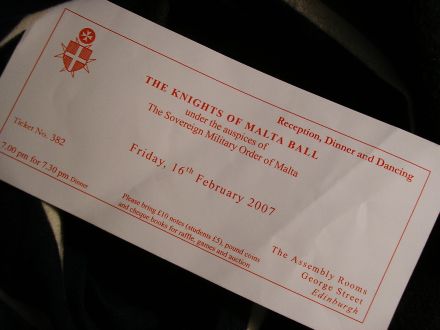
Search
Instagram: @andcusack
Click here for my Instagram photos.Most Recent Posts
- Sag Harbor Cinema March 26, 2025
- Teutonic Takeover March 10, 2025
- Katalin Bánffy-Jelen, R.I.P. March 3, 2025
- Substack Cusackiensis March 3, 2025
- In the Courts of the Lord February 13, 2025
Most Recent Comments
Book Wishlist
Monthly Archives
Categories


